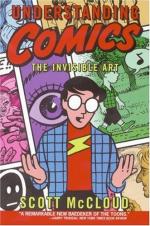
|
| Name: _________________________ | Period: ___________________ |
This test consists of 5 short answer questions, 10 short essay questions, and 1 (of 3) essay topics.
Short Answer Questions
1. The bold lines, obtuse angles and heavy blacks in Dick Tracy were meant to suggest a _________ of adults.
2. The four color process on better paper created what kind of results?
3. Which of the following is not a benefit from non-basic human activities such as art?
4. What combination has words that amplify or elaborate on an image, or vice versa?
5. The pursuit of truth can be seen as the foundation of which of the following?
Short Essay Questions
1. How can an artist depict emotion in a comic?
2. What was one result of the color printing used for superheroes?
3. Describe the typical artist who finds idea/purpose after creating art.
4. What is synaesthetics?
5. Describe the origin of words.
6. What are the disadvantages of color in comics?
7. How can backgrounds indicate invisible ideas such as emotions?
8. In Chapter 7, how does McCloud see, or define, art?
9. How does McCloud feel about color and comics?
10. How can words and pictures together create a more meaningful message than each individually?
Essay Topics
Write an essay for ONE of the following topics:
Essay Topic 1
McCloud notes that diagrams are comics, but they do not label themselves as such. How important are labels? Would a rose by any other name smell as sweet? How does the context that diagrams are presented in make them different from other comics?
Essay Topic 2
Art can be thought of as any human activity that doesn't grow out of either basic instinct of survival and reproduction. How do you define art? According to this definition, what are examples of what is and isn't art?
Essay Topic 3
The invention of printing played a significant role in the history and the world of comics (and the written word). Think of another invention that had a significant impact. What were the effects? Did it solve a problem or enable further development? Where would we be without the invention? Be specific and select a physical invention - do not use "technology" or other broad concepts.
|
This section contains 763 words (approx. 3 pages at 300 words per page) |

|




